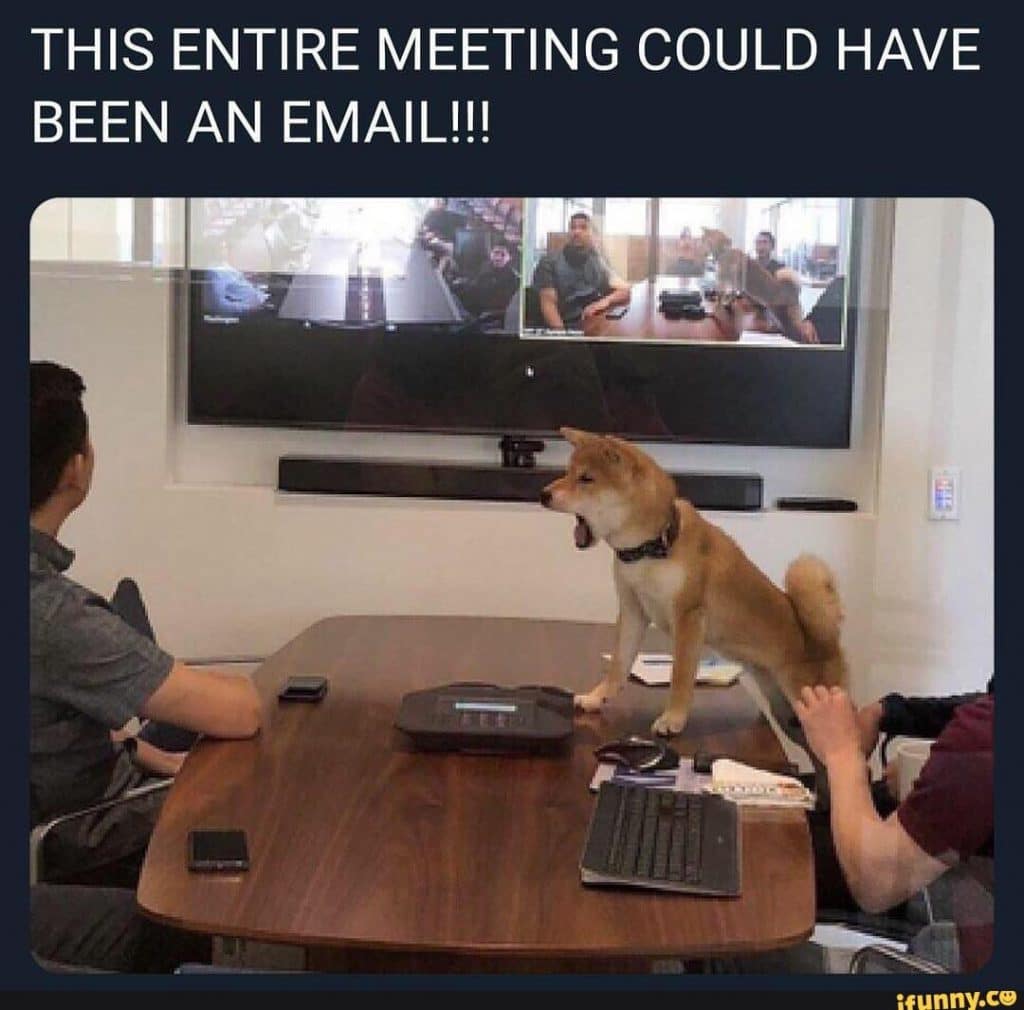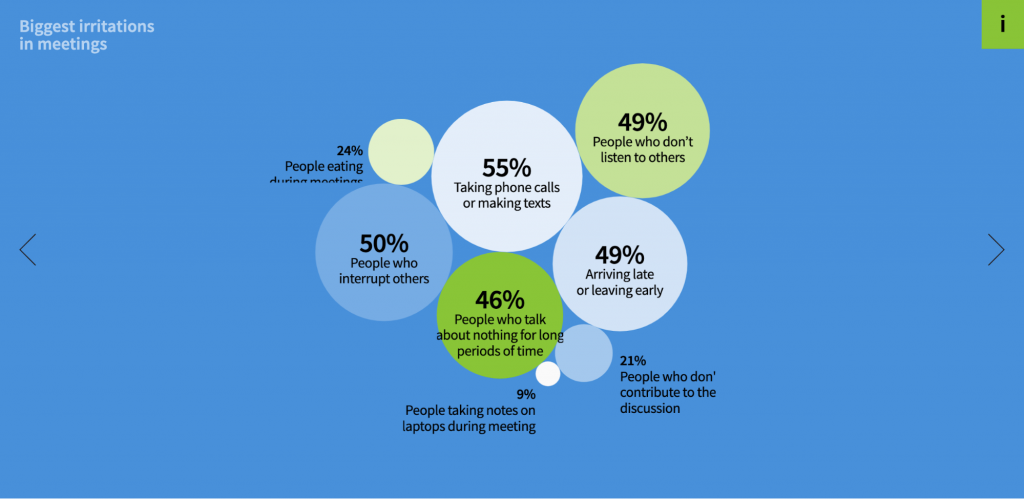We know, we know, it’s tempting.
Imagine: There are about 20 people on this video meeting and only two of them are talking.
Ainsley has been droning on for about eight minutes straight, and John before that. Both of them have been taking turns for the past hour, and you’re very sure that nobody has noticed you’ve been munching on a bag of Cheetos all this while.
It wouldn’t hurt to pull up that PowerPoint deck that’s overdue—which you probably would have submitted on time if not for meetings just like this one…

It’s almost thrilling (like cutting class in high school) to think about just nodding at your crossword puzzle while solving it—while looking like you’re taking diligent notes.
But don’t do it.
🔍 Are you thinking about purchasing a new online meeting tool and unsure how to get started? Here’s a checklist to help you pick the right one for your business.
In this post, we’ll cover:
- 4 bad things that happen when you multitask during video meetings
- How to resist multitasking—even when you really want to
- How to run meetings that nobody will want to multitask in
If you’re curious about some of the most common challenges that are created by modern meetings, here’s quick clip from our Better Meetings Masterclass that talk about how to overcome them:
Why you shouldn’t multitask during video meetings
Multitasking is an epidemic. Everyone does it, even managers who say they spend all day in meetings and don’t have the time to finish their work.

Source: hbr.org/2018/01/if-you-multitask-during-meetings-your-team-will-too
When it comes to online meetings and conference calls, it’s all the easier to ignore the etiquette, tune out, and do your own thing.
Here are some reasons you should exercise some restraint and nip this bad habit in the bud.
1. It’s really annoying
You know that moment when you’ve spoken for five minutes straight about something, and someone who was present later insists you’d never said it (because he was distracted while you were speaking)? It’s tiresome and inefficient to have to bring everyone on the same page repeatedly.

Source: Doodle | https://meeting-report.com/personal-impact-of-meetings/2
According to Doodle’s The State of Meetings Report (2019), people really hate it when attendees take phone calls or text during a meeting. It’s among the chief irritants, followed by being interrupted and tardiness.
2. It’s disrespectful of others’ time
Most people find meetings a drag, but they still wring out their work schedules to make sure they’re present for them. The value of their presence and time doesn’t diminish over video.
When leaders find it acceptable to divert their attention to other activities, it makes the people who’ve made time to be present feel unimportant or that their time and presence aren’t valued.
3. It sets the tone for poor team culture
If you’re a team leader and you begin checking your email or conversing with your partner while in a meeting, you’re essentially telling your team that it is totally okay for them to do the same. All in all, this makes for terrible team culture.
4. Multitasking harms your brain
The human brain is not made for multitasking and can actually suffer for it.
Some participants in a University of London study showed an IQ drop of up to 15 points when they multitasked1. Studies have also proven that multitasking isn’t even efficient2—only about 2.5% of people can multitask without their performance dropping3, and it’s more likely that you’re not in that group.

How to resist multitasking… even though you really want to
Most of us are aware that multitasking during meetings is neither polite nor advisable from a brain health point of view. We still do it anyway because single-tasking is boring. But virtual meetings don’t have to make it worse.
If you’re a leader, you have the power to encourage a culture of better meetings where people love being present and leave feeling valued (more on how in the next section).
If you don’t have a say in how meetings are run, try to excuse yourself from them.
Decline to attend meetings where you know that your presence or contribution is not required. For instance, if you know in advance that the discussion of the day will be about an account you’re not part of, consider asking your boss if you can skip it.
Two things can come out of this: either your boss will agree, or you’ll learn why you’re in that meeting and what you’re expected to contribute.
If this doesn’t work, try this:
1. Stand up
This tip is handy, particularly during those post-lunch afternoon meetings. Standing up helps your blood sugar levels return to normal faster and may even reduce the risk of shoulder and back pain4.
It can also help you remain alert. During video meetings, nobody will know—or even mind—that you’re standing.
2. Take meeting minutes
Volunteer to take notes during the meeting. Even better, handwrite them if you can. This will allow you to focus on what’s going on as well as contribute to the entire team when the meeting is over. Just be careful not to trail off into doodling.
3. Come prepared
If your meetings come with an agenda, go over it in advance and make it a point to come prepared with what you’d like to bring up.
To avoid people multitasking in your meetings, do this:
If you’re a manager who has a say in how meetings can and should be run, have a conversation with your team members and raise your concerns about multitasking. Then, try incorporating these tips to curb this damaging habit:
1. Run short meetings
If your team is used to sprawling, hour-long report-outs, it’s unrealistic to aim straight for five-minute meetings. Instead, aim to cut them down by about 15 minutes at a time and use that extra time to send texts and emails instead.
2. Try to make meetings interactive
Use RingCentral Video’s screen sharing and annotation tools to “draw out” your points and invite your teammates to participate in discussions and brainstorming sessions:
Give everyone an opportunity to speak and, if possible, give them a role. This will make it less likely that they’ll zone out.
3. Ask participants to turn on the video and unmute
There’s nothing like video conferencing to make you sit up and at least try to “look” attentive. And do remember, you’re far more easily ignored in a crowded room than you are in a video meeting where people have a close-up, screenshot-able view of your face.
Is it always a terrible thing to multitask in online meetings?
Fun fact: Multitasking can be as detrimental to your mental health as not sleeping5, and that reason alone should make you think about whether you should multitask at all, let alone in a meeting.
But if you find yourself unable or unwilling to change this habit, perhaps you should spend some time introspecting. Are you struggling with time management? Are you feeling disengaged from work?
Answering these questions can go a long way in improving both your mental health and the quality of your work life.
1 discovery.ucl.ac.uk/id/eprint/1465496
2 apa.org/pubs/journals/xhp/index
3 thecut.com/2015/05/brains-of-super-multitaskers-are-different.html
4 health.harvard.edu/blog/the-truth-behind-standing-desks-2016092310264
5 appliedpsychologydegree.usc.edu/blog/to-multitask-or-not-to-multitask/
Originally published Mar 26, 2020, updated Jun 23, 2021






